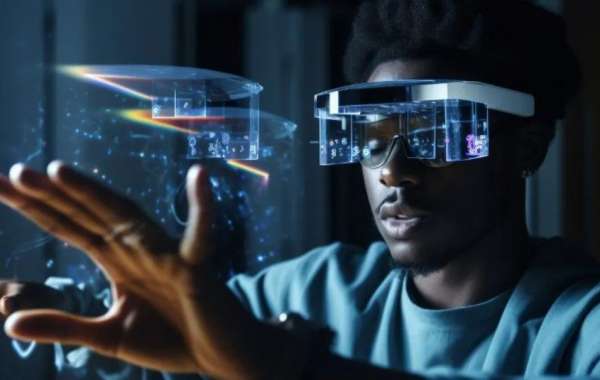Spatial computing platforms are the driving force behind many of the immersive technologies that are shaping the digital world in 2024. These platforms enable seamless integration of the physical and digital realms, allowing users to interact with the world around them in new and exciting ways. As this field continues to evolve, certain key features set the leading spatial computing platforms apart from the rest.
1. Real-Time Spatial Mapping and Localization
One of the fundamental features of any spatial computing platform is its ability to understand and map the physical environment in real-time. Spatial mapping refers to the platform's ability to scan and create a digital representation of the user's surroundings. Using advanced sensors, cameras, and depth sensors, the platform can recognize objects, obstacles, and surfaces, allowing it to create a dynamic, interactive 3D model of the environment.
Localization refers to the platform's ability to understand where the user is within that environment. This is essential for applications in AR and VR, where the virtual content must align with the physical world. Leading spatial computing platforms excel at accurately tracking the user’s position and orientation, even in complex, changing environments.
Why it matters: Real-time spatial mapping and localization are crucial for creating realistic and immersive experiences. Without precise spatial understanding, AR/VR experiences would feel disjointed and less engaging, which is why this feature is foundational in leading spatial computing platforms.
2. Multi-User Interaction
One of the most exciting aspects of spatial computing platforms is their ability to support multiple users interacting in the same virtual space. Whether it's a virtual meeting, a collaborative design project, or a multiplayer gaming environment, multi-user interaction is becoming increasingly important.
Leading spatial computing platforms provide tools for synchronization, allowing multiple users to see and interact with the same digital objects in real-time. This involves accurate hand tracking, gesture recognition, and networked environments that let users experience shared spaces together.
Why it matters: Multi-user capabilities extend the potential of spatial computing, allowing for collaboration and social interaction in ways that were previously impossible. This is particularly important for industries like education, where students can explore virtual environments together, or for remote teams working in a shared digital workspace.
3. Advanced Gesture and Voice Control
A crucial feature of spatial computing platforms is the ability to interact with virtual content without the need for traditional input devices like keyboards or mice. Gesture control uses sensors or cameras to track hand movements, allowing users to manipulate objects, navigate menus, or perform tasks through intuitive hand gestures. Voice control, on the other hand, leverages natural language processing to understand spoken commands and perform tasks accordingly.
Leading platforms combine both gesture and voice control to create more seamless and immersive experiences. For instance, users can verbally command a virtual assistant to perform an action while simultaneously gesturing to interact with a 3D object in space.
Why it matters: Gesture and voice control make spatial computing platforms more intuitive and user-friendly, allowing users to engage with the platform in a natural, human-like way. These features are essential for making spatial computing accessible to a wide range of users, from gamers to professionals.
4. Realistic Environmental Interactions
Leading spatial computing platforms excel in providing realistic interactions with both digital and physical elements within the environment. These platforms use sophisticated physics simulations and haptic feedback to make virtual objects behave as if they were real. This includes providing tactile feedback through controllers or wearables that simulate the feeling of interacting with virtual objects, as well as accurately simulating how objects should react in the physical world (e.g., gravity, friction, and collision detection).
For example, in a VR game, users may feel the sensation of “touching” a virtual object, or a digital ball may bounce according to the laws of physics.
Why it matters: Realistic environmental interactions are what make spatial computing truly immersive. They enhance user engagement by making digital experiences feel more tangible and natural. This feature is critical for applications in gaming, training, simulations, and design.
5. Cross-Platform Compatibility
As spatial computing technologies evolve, one of the most important features is the ability for platforms to work across different devices. Leading spatial computing platforms support a wide range of hardware, from smartphones and tablets to AR glasses, VR headsets, and even wearable devices.
This cross-platform compatibility ensures that users can access and interact with spatial computing experiences regardless of the device they are using. Whether you’re on a mobile phone running an AR app, or in a fully immersive VR environment, leading spatial computing platforms ensure a consistent experience across all devices.
Why it matters: Cross-platform compatibility ensures that users aren’t locked into a specific hardware ecosystem, giving them the flexibility to use whatever device is most convenient. This opens the door for broader adoption and more versatile use cases.
6. AI Integration and Machine Learning
Artificial Intelligence (AI) and Machine Learning (ML) are key to making spatial computing platforms smarter and more adaptable. AI is used to process vast amounts of data generated by sensors, cameras, and other inputs in real-time. Machine learning models allow these platforms to learn from their environment and improve over time, enabling more sophisticated interactions and predictions.
For instance, a spatial computing platform might learn to recognize objects within its environment or predict user actions based on previous behavior. These AI-powered capabilities make platforms more responsive and intuitive, enhancing the overall user experience.
Why it matters: AI and ML integration are vital for spatial computing platforms to evolve and become more intelligent. These technologies enable platforms to adapt to user behavior, personalize experiences, and provide more advanced functionality, all of which improve user engagement and effectiveness.
7. Cloud Connectivity and Data Synchronization
To support complex spatial computing applications, especially those requiring vast amounts of data or real-time collaboration, cloud connectivity is becoming increasingly important. Leading spatial computing platforms utilize cloud computing to store, manage, and synchronize large datasets in real-time. This ensures that users have access to up-to-date information and can seamlessly collaborate across different locations.
Why it matters: Cloud connectivity and data synchronization ensure that users can access their spatial computing experiences from anywhere, on any device. This is essential for industries like design, healthcare, and education, where users need to access and manipulate large datasets across multiple devices and locations.
Conclusion
The leading spatial computing platforms of 2024 are packed with features that enable immersive, intuitive, and transformative experiences. From real-time spatial mapping to multi-user interaction and AI-powered enhancements, these platforms are not only reshaping how we interact with digital content but also expanding the possibilities of what can be achieved in various industries. Understanding these features helps businesses, developers, and users navigate the evolving landscape of spatial computing and take advantage of its many opportunities.




